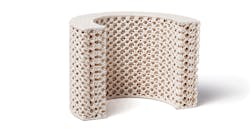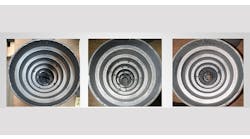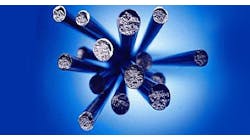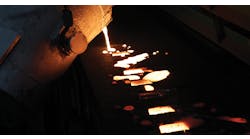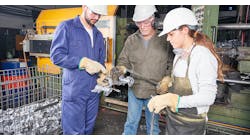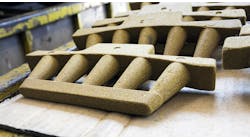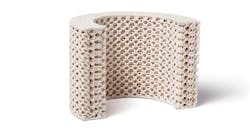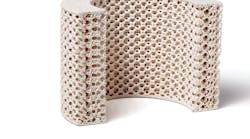Latest from Ask the Expert
3D Printing Enhances Filtration Possibilities and Casting Results
Q: We need to need to filter molten metal for a large casting to eliminate inclusions and reduce clean room costs, but the currently available filter technologies are insufficient – mainly because the filter material “plugs off” too quickly during the pouring sequence. What products are available to address this?
A: For this issue there are a few different technical solutions for you to consider. The first would to be rig-up your gating system to filter through multiple filters, to handle the increased capacity required for pouring large-scale castings.
Another possible solution might be to filter through an assembly piece with multiple filters, or a filter with increased surface area, such as a tube.
A third option would be to find a filter that can handle the same thermal shock properties as a conventional filter, and would have an engineered design to allow for the increased capacity — and still would supply the filtration capabilities required to eliminate the inclusions you describe.
Among these three options, the easiest to implement and most cost-effective would be the third option. Next, with all the metal-filtering technologies out there you would need to find such a filter. And now, and the most viable place to find such an ideal product would be in the emerging venue of additive manufacturing. In other words, a “3D-printed filter.”
Recently, ASK Chemicals introduced its EXACTPORE 3D line, which would check all the boxes required to solve your issue. These filters offer iron and steel foundries (as well as investment casters) new and more efficient filtration options for the highest casting quality. Thanks to their particularly sophisticated and well thought-through design, EXACTPORE 3D filters provide the highest structural integrity and thus safety and efficiency in use.
Metal purity is one of the most important requirements for foundries: “Best practice” molten-metal filtration includes sintered ceramic foam filters, but the structure of the filter foams in particular means that this form of filtration also has its limits. During the ceramic coating and sintering process, tiny particles may form inside the filter structure, which are only slightly sintered with the base material. Flow through the filter can cause these particles to detach, which impairs the purity of the melt and can lead to inclusions in the casting.
The high structural integrity of EXACTPORE 3D filters ensures the absence of loose particles and thus prevents the contamination of the melt by so-called filter bits and time-consuming reworking.
A further advantage of the new filter generation is its higher flow capacity. Due to the uniformity of the pore design and the structurally consistent geometry, the flow capacity of the EXACTPORE 3D filters is significantly higher than sintered ceramic foam filters with the same filter and pore size, and thus offers foundries an opportunity to further increase manufacturing productivity.
The uniformity of the pore design and the structural integrity of the new filters also significantly reduces turbulence compared to conventional solutions and greatly protects against reoxidation caused by entrained air. In fact, hardly any impurities get into the mold, which leads to less reworking, improved surface quality and lower rejection rates and ultimately increases profitability.
“Finally, our new filters are manufactured in such a way that the design possibilities are virtually limitless,” according to Bob Gage, market manager-Filters, referring to the flexibility and variability that is possible thanks to additive manufacturing of the new EXACTPORE 3D filters.
“With our new filters there are almost no limitations as to what we can offer our customers in terms of pore design,” he emphasized. “We can produce almost any pore size – even unconventional ones – in order to guarantee the best possible filter quality with constant flow properties.”
Join the Conversation. Email Your Questions for ASK Chemicals
Share your insights, opinions, and elaborate on the questions and the experts' answer(s). You must be logged in to the website in order to post your comments.
